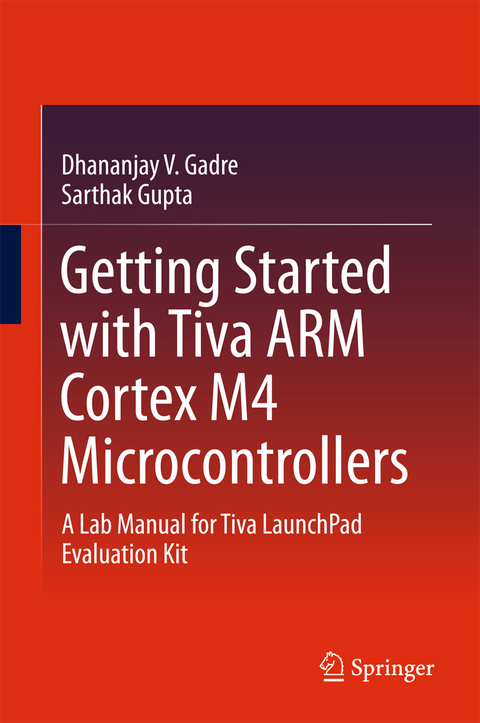
Getting Started with Tiva ARM Cortex M4 Microcontrollers
Springer, India, Private Ltd (Verlag)
978-81-322-3764-8 (ISBN)
Dhananjay V. Gadre (New Delhi, India) completed his M.Sc. (Electronic Science) from the University of Delhi and M.Engg (Computer Engineering) from the University of Idaho, USA. In his professional career of more than 27 years, he has taught at the SGTB Khalsa College, University of Delhi, worked as a scientific officer at the Inter-University Centre for Astronomy and Astrophysics (IUCAA), Pune, and since 2001, has been with the Electronics and Communication Engineering Division, Netaji Subhas Institute of Technology (NSIT), New Delhi, currently as an Associate Professor. He directs two open access laboratories at NSIT, namely Centre for Electronics Design and Technology (CEDT) and TI Centre for Embedded Product Design (TI-CEPD). Professor Gadre is the author of several professional articles and five books. One of his books has been translated into Chinese and another one into Greek. His recent book “TinyAVR Microcontroller Projects for the Evil Genius”, published by McGraw-Hill International, consists of more than 30 hands-on projects and has been translated into Chinese and Russian. He is a licensed radio amateur with a call sign VU2NOX and hopes to design and build an amateur radio satellite in the near future. Sarthak Gupta completed his Bachelor of Engineering (Electronics and Communication Engineering) from the Netaji Subhas Institute of Technology (NSIT), Delhi in 2014. During college he worked extensively on embedded systems design using AVR and ARM based microcontrollers. He also worked on reconfigurable hardware like field-programmable gate arrays (FPGAs) and complex programmable logic devices (CPLDs). From June 2013 to May 2014, he worked as a Texas Instruments (India) intern at the TI Centre for Embedded Product Design (TI-CEPD) under the tutelage of ProfessorGadre. From July 2014 to December 2015, he worked at Texas Instruments (India) at their Bangalore office as a design engineer working on the design and verification ofARM Cortex M0+ based microcontrollers, memory controllers and memory test chips. From July 2017, Sarthak plans to join the Indian Institute of Science (IISC), Bangalore as a postgraduate student pursuing Masters of Technology (M.Tech.) course in Electronic Systems Engineering.
Introduction.- Chapter 1 ARM Cortex-M4 Core and Tiva C Series Peripherals.- Chapter Tiva C Series LaunchPad.- Chapter 2 PadmaBoard-Peripheral Motherboard of Tiva C Series LaunchPad.- Chapter 3 Tiva C Series Controller Breakout Board(BOB).- Chapter 4 GNU ARM Toolchain.- Chapter 5 Anatomy of C Program.- Chapter 6 Application Programming Interface (API).- Chapter 7 Digital Input/Output.- Chapter 8 Interrupts.- Chapter 9 Timers.- Chapter 10 Universal Asynchronous Receiver and Transmitter (UART).- Chapter 11 Power Management and System Control.- Chapter 12 Analog to Digital Converter(ADC).- Chapter 13 User Input/Output Devices.- Chapter 14 Tiva C Series Based Standalone Projects.
| Erscheinungsdatum | 09.11.2017 |
|---|---|
| Zusatzinfo | 163 Illustrations, black and white; XXI, 271 p. 163 illus. |
| Verlagsort | New Delhi |
| Sprache | englisch |
| Maße | 155 x 235 mm |
| Themenwelt | Informatik ► Theorie / Studium ► Algorithmen |
| Informatik ► Weitere Themen ► Hardware | |
| Technik ► Elektrotechnik / Energietechnik | |
| Schlagworte | 32-bit RISC • ARM architecture • ARM Microcontroller • bootloader • Cortex-M4 • Microcontroller Programming • Physical Interfacing • SysTick Timer • Tivaware API Library |
| ISBN-10 | 81-322-3764-1 / 8132237641 |
| ISBN-13 | 978-81-322-3764-8 / 9788132237648 |
| Zustand | Neuware |
| Haben Sie eine Frage zum Produkt? |
aus dem Bereich


